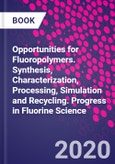Fluoropolymers are very unique materials. Since the middle of the twentieth century fluoropolymers have been used in applications where a wide temperature range, a high resistance to aggressive media, excellent tribological characteristics, and specific low adhesion are required. Today, researchers turn to fluoropolymers to solve new challenges and to develop materials with previously unattainable properties.
Opportunities for Fluoropolymers: Synthesis, Characterization, Processing, Simulation and Recycling covers recent developments in fluoropolymers, including synthesis of new copolymers, strategies for radical polymerization of fluoromonomers (conventional or controlled; RDRP), and the modification of fluoropolymers to achieve desired material characteristics. This volume in the Progress in Fluorine Science series is ideal for researchers and engineers who want to learn about the synthetic strategies, properties, and recycling of these special polymers, as well as industrial manufacturers who are interested in achieving new product characteristics in their respective industries.
Please Note: This is an On Demand product, delivery may take up to 11 working days after payment has been received.
Table of Contents
1. Semi-fluorinated Aromatic Ether Polymers via Step-growth Polymerization of Fluoroalkenes2. Iodine transfer emulsion polymerizations of vinylidene fluoride
3. Fluorinated compounds as mediators in controlled radical polymerization
4. Specifics of the Mn2(CO)10 Photomediated Synthesis of PVDF Block Copolymers
5. Fluoropolymers by initiated Chemical Vapor Deposition (iCVD)
6. Supramolecular structure of gamma-irradiated polytetrafluoroethylene
7. Preparation and applications of fluoroalkyl end-capped oligomeric composites
8. Fluoropolymers for water/oil separation
9. PVDF-based Shape Memory Materials
10. Manufacturing Strategies in Fluorinated Polymers and Composites
11. Mineralization of Fluoropolymers Using Subcritical Water
Authors
Bruno Ameduri Institute Charles Gerhardt, Macromolecular Architectures Team, University of Montpellier, CNRS, ENSCM, Montpellier, France. Dr. Bruno Ameduri (DR CNRS Senior Researcher) leads the "Fluorine� Group at the "Engineering and Macromolecular Architectures� Team of Institute Charles Gerhardt in Montpellier, France. His main interests focus on the synthesis and the characterization of fluorinated monomers (including cure site monomers, telechelics, and polyfunctional ones), telomers, and copolymers for various applications such as F-surfactants, F-elastomers, F-coatings, and F-polymers related to energy (fuel cell membranes-protonic, alkaline and quasianhydrous ones-, polymer gel electrolytes and separators for Li-ions batteries, piezo-, ferro- or electroactive films, and nanocomposites).Coauthor of three books, ca. 45 reviews or book chapters, >360 peer review publications and coinventor of more than 80 patents, he is also a member of the American and French Chemical Societies and is a member of the Editorial Boards of the Journal of Fluorine Chemistry, European Polymer Journal, Polymer Bulletin. Outside of research, Bruno enjoys cycling, soccer, tennis, and jogging and is an active member of the "Rire� Association and visits, dressed as a clown, sick children in hospitals of Montpellier. Sergey Fomin Director of the Institute of Chemistry and Ecology, Vyatka State University, Russian Federation. Sergey Fomin is the Director of the Institute of Chemistry and Ecology of Vyatka State University (Russian Federation, Kirov). His main research interests are in the field of adhesion of polymer materials, development of new ingredients for polymer compositions, modeling and calculations of polymer products. The main research objects are elastomers of various purposes, including fluoro-rubber, but also a great deal of attention is paid to thermoplastic fluoropolymer materials. He led more than ten research and design projects for industry (including for improving the frost resistance of rubber, the development of production technology of self-healing pneumatic tires, the development of methods for assessing the content of polyaromatic hydrocarbons in rubber, the creation of a new production of polymer monofilament, the creation of a new production of polymer materials resistant to aggressive media, etc.). He has co-authored more than 30 articles in peer-reviewed publications, 4 patents. He was the co-organizer of the conference with Dr. Ameduri. He is a member of the Nanotechnology Society of Russia. Personal interests: music, playing electric guitar, snowboarding, running.








